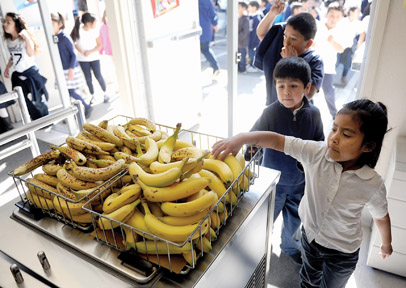In life, there’s rarely a free lunch, but there might be more gratuitous meals for students in the Hollister School District next year.
District officials are applying for a federal program that would provide students at select school sites – or possibly districtwide – with free breakfast and lunch each day. Called the Community Eligibility Provision, the program would bring two free meals to all pupils at high-poverty schools where at least 40 percent of the students currently qualify for free breakfast and lunch.
“I’ll be honest with you – I think we’re pretty close,” said John Teliha, the district’s director of nutrition, maintenance, operations and warehouse services, last week as he considered the percentage of district students currently qualifying for free meals.
The catch is that the federal program will only reimburse the schools for the price of the meals of students that currently qualify for free breakfasts and lunches – and the district will have to pick up the tab for the rest of the free food.
School officials hope the program will decrease the burden on administrators who will be able to waive all students through lines without pausing to distinguish the free, reduced-price or paid meal takers. The idea behind the program is that faster lines and free food will encourage more students at high-poverty schools to eat a healthy, well-balanced meal.
“That is something we’re looking at right now to see if we have the numbers,” Teliha said. “They’re offering a program where everyone can eat for free.”
Students qualify as part of the 40 percent if they receive free meals because they are homeless, migrants, foster children or part of the Head Start program; or are recipients of CalFresh, California Work Opportunity and Responsibility to Kids (CalWorks) or the Food Distribution Program on Indian Reservations.
Individual schools can qualify for the CEP program, or the district can organize campuses into groups where the average percentage of students receiving a free meal is at least 40 percent.
In addition to reviewing numbers to see if schools qualify for the program, administrators need to determine if it makes fiscal sense. At a site where 40 percent of the students qualify for free meals, the district would have to pick up the tab for the remaining 60 percent of the pupils’ food. Money that isn’t in the district’s student nutrition fund would have to come from the general fund, Teliha explained.
That said, if some schools took advantage of the CEP program and others – with lower percentages of pupils qualifying for free meals keep the pay-as-you-eat program – money will continue to move into the district’s student nutrition fund and could be used to pay for food at any school site.
This school year will be the first time that California participates in the new CEP program, which started in Illinois, Kentucky and Michigan three years ago. To date, 11 states are participating in the program, which will open to schools in every state across the nation next school year.
Originally, school districts applying for the Community Eligibility Provision had to submit a form to the California Department of Education by June 30, but the deadline has been extended to Aug. 31.
Increased meal prices
At the same time that HSD is applying to make meals free to all students, school board trustees voted to increase the cost of paid lunches Tuesday July 22 without discussion, as the item was part of the meeting’s consent agenda. The district increased the price of school lunches by $0.25 per meal in accordance with the Healthy, Hunger-Free Kids Act of 2010’s call to narrow the cost between the price of making a lunch and the amount students pay to eat it. The district will bring in $14,415 next year from this increase and they will plow $11,854 of this into subsidizing their reduced price lunch program, which means that students qualifying for the reduced price meals will now eat for free.
“Instead of the fund just growing… I’d rather take that money and help subsidize that (reduced price lunch) program and give more students an opportunity to eat,” Teliha said.
The lunch price increase is the first in the district since 2011.










